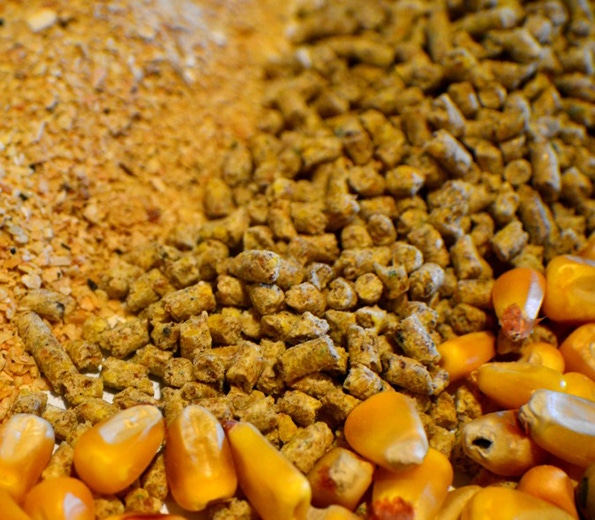Pelleting and extrusion increase digestible and metabolizable energy in diets for pigs
Scientists at the University of Illinois using co-products from the ethanol and human food industries are helping shed light on ways processing high-fiber animal feed ingredients can enhance pigs’ utilization of the nutrients and energy they contain.
July 6, 2016

Scientists at the University of Illinois using co-products from the ethanol and human food industries are helping shed light on ways processing high-fiber animal feed ingredients can enhance pigs’ utilization of the nutrients and energy they contain. The co-products from these industries typically contain more fiber than the standard corn-soybean meal diet.
“It is possible that the benefits of extrusion and pelleting are greater in high-fiber diets than in low-fiber diets. We set out to test that hypothesis,” says Hans H. Stein, professor of animal sciences at the University of Illinois.
Stein and his team tested effects of extrusion, pelleting, or extrusion and pelleting: using a low-fiber diet based on corn and soybean meal; a medium-fiber diet containing corn, soybean meal, and 25% distillers dried grains with solubles; and a high-fiber diet containing corn, soybean meal, 25% DDGS and 20% soybean hulls.
Each diet was divided into four batches. One batch was fed in meal form, one was pelleted at 85 degrees C, one was extruded at 115 degrees C, and the fourth was extruded at 115 degrees C and then pelleted at 85 degrees C.
“Regardless of the concentration of fiber in the diet, pelleting, extrusion, and pelleting plus extrusion increased the digestibility of indispensable amino acids relative to feeding in meal form,” Stein says. “For most indispensable amino acids, extrusion or extrusion combined with pelleting provided a greater increase than pelleting alone. There was no interaction between processing techniques and fiber level.”
Research highlights ►Pelleting, extrusion, and pelleting plus extrusion increased the digestibility of indispensable amino acids ►Pelleting of low-fiber diets increases digestible energy by 1.9% and metabolizable energy by 2.1% ►Pelleting of medium-fiber diets increases digestible energy by 1.9% and metabolizable by 2.2% ►Pelleting did not increase digestible energy or metabolizable energy of high-fiber diets, but extrusion increased digestible energy by 2.0% and metabolizable by 2.9% ►Energy utilization may be improved by pelleting, extrusion, or by a combination of the two, but the response seems to be greater for extrusion in diets that are relatively high in fiber |
Pelleting of low-fiber diets increased digestible energy by 1.9% and metabolizable energy by 2.1%. Extrusion did not increase digestible energy or metabolizable energy of the low-fiber diet. Combining extrusion with pelleting did not increase digestible energy or metabolizable energy compared with pelleting alone.
For the medium-fiber diets, pelleting increased digestible energy by 1.9% and metabolizable by 2.2%. Extrusion increased digestible by 2.3% and metabolizable energy by 2.7%. The combination of pelleting and extrusion did not increase digestible energy or metabolizable energy in these diets.
Pelleting did not increase digestible energy or metabolizable of the high-fiber diets. Extrusion increased digestible energy by 2.0% and metabolizable by 2.9%. The combination of extrusion and pelleting increased digestible energy by 2.9% and metabolizable energy by 3.7%.
Hindgut fermentation was not increased in pigs fed extruded, pelleted, or extruded and pelleted diets. Instead, the increase in digestible energy and metabolizable energy appeared to be attributable to increased digestibility of amino acids and starch.
Stein concludes, “These data indicate that energy utilization may be improved by pelleting or extrusion or by a combination of the two, but the response seems to be greater for extrusion in diets that are relatively high in fiber.”
The research is supported by funding from the National Pork Board and by Bühler AG, Uzwil, Switzerland.
“Effects of pelleting, extrusion, or extrusion and pelleting on energy and nutrient digestibility in diets containing different levels of fiber and fed to growing pigs,” is published in the Journal of Animal Science. Oscar Rojas, formerly of the University of Illinois and now of Devenish Nutrition, and Ester Vinyeta of Bühler AG are co-authors.
You May Also Like


